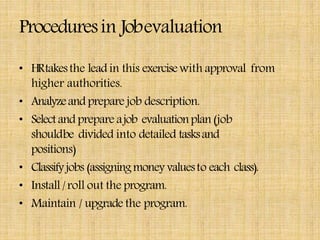Job evaluation scope_process
- 1. JobEvaluation Presented by :- Saurabh Kumar MBA
- 2. Definitionandscope ŌĆó Jobevaluation isthe processof determining the worth of onejob in relation to that of the other jobs in a company. ŌĆó Isaprocessof determining the relativeworth of a job. ŌĆó Aneffort todetermine the relative valueof every job in anorganization. ŌĆó Apractical technique to judge the sizeofonejob relative to others.
- 3. Definition and scope (continued) Studyingor analyzingthe value, importance, and necessityof aparticularjob Keyfactors consideredfor Jobevaluationare: ŌĆó Volume of Responsibilities ŌĆó Output/deliverables ŌĆó General/Specialty ŌĆó Decision makers/decision followers ŌĆó Emerging needs of the company
- 4. Objectives of JobEvaluation ŌĆó Togather data and information relating to job description, job specification and employee specificationsof various jobs in anorganization. ŌĆó Tocompare the duties, responsibilities and demands of ajob with that of other jobs. ŌĆó Todetermine the hierarchy /rank basedon jobsin an organization. ŌĆó Toensureequal wagesare fixed to the jobsof equal worth orvalue. ŌĆó Tominimize wagediscrimination basedon sex, age, caste,region, religion etc.
- 5. Principles of Jobevaluation ŌĆó Ratethe job but not the employee. ŌĆó Elements/ tasksselectedshould beeasilyunderstood, defined clearly andproperlyselected. ŌĆó Employeeconcernedandsupervisorsshould beeducated and convincedabout theprogram else they may resist. ŌĆó Supervisorsshould beencouragedto participate inrating the jobs becausethey have a better idea about the specificjobs.. ŌĆó Encourageemployee cooperation to participate inthe rating program. ŌĆó Consensuswith the supervisorsandemployeesonrating. ŌĆó Shouldbeacollective effort, chanceforequal representation from alldepartments.
- 6. Proceduresin Jobevaluation ŌĆó HRtakesthe lead in this exercisewith approval from higher authorities. ŌĆó Analyzeand prepare job description. ŌĆó Selectand prepare ajob evaluationplan(job shouldbe divided into detailed tasksand positions) ŌĆó Classifyjobs (assigningmoney valuesto each class). ŌĆó Install /roll out the program. ŌĆó Maintain / upgrade the program.
- 7. Process of job evaluation 1. Preliminary Stage:- Required information is obtained about present arrangements. Decision is taken whether to revise the existing one or to create a new one. 2. Planning stage:- Evaluation program is drawn up and job holders to be affected are informed about it. 3. Analysis stage:- Required information about the sample of jobs is collected. It serves as the base for the internal and external evaluation of jobs.
- 8. Process (continued) 4. Internal evaluation stage:- The sample of benchmark jobs are ranked by the means of chosen evaluation schemes. Jobs are then graded and relative worth of the jobs is ascertained. 5. External evaluation stage:- In this stage information is collected about market rates at that time. 6. Design structure :- Now after step 5 and 6, grades of the jobs have been ascertained the salary structure is designed in this stage.
- 9. Process (continued) . 7. Grading stage :- In this stage salaries are slotted in a salary structure. 8. Developing and maintenance stage:- In this stage, procedures for maintaining the salary structure are developed with a view to grade new jobs into the structure and reporting the existing jobs in the light of changes in their responsibilities and market rates.










